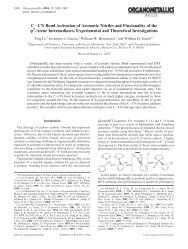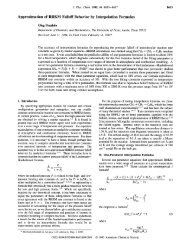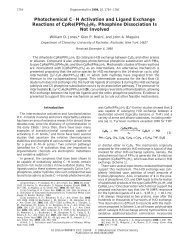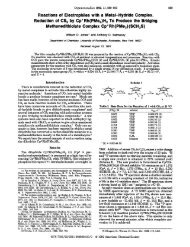ch 41.2.2-kadosh - Chemistry
ch 41.2.2-kadosh - Chemistry
ch 41.2.2-kadosh - Chemistry
You also want an ePaper? Increase the reach of your titles
YUMPU automatically turns print PDFs into web optimized ePapers that Google loves.
Au: Wang<br />
is not in ref<br />
87?<br />
4<br />
functional theory (DFT) with the VASP code. 83–85 The<br />
periodic boundary conditions and plane wave basis sets<br />
of the VASP code are especially effective for extended<br />
periodic systems su<strong>ch</strong> as semiconductors. The core<br />
electrons are simulated using the Vanderbilt pseudopotentials,<br />
86 and only the valence electrons are treated<br />
explicitly. The generalized gradient functional due to<br />
Perdew and Wang 87 is used. The energy cutoff for the<br />
plane wave basis was 202.7 eV, yielding a basis set of<br />
approximately 112,000 plane waves. The Kohn–Sham<br />
orbitals are constructed from the plane wave basis set<br />
and are used to describe the electronic states of the<br />
system.<br />
The assembled structure of the dye on the TiO 2 surface<br />
is brought to equilibrium at the temperature of<br />
350 K. A 1 fs MD timestep is used. Upon equilibration,<br />
a 1-ps adiabatic ground state MD trajectory is run in the<br />
microcanonical ensemble. This is the production run for<br />
NA MD.<br />
Under the assumption that the ET dynamics are<br />
dominated by thermal fluctuations of ions, su<strong>ch</strong> that ion<br />
dynamics are similar in the ground and excited electronic<br />
states, only the ground state trajectory data are<br />
needed to perform NA MD. For ea<strong>ch</strong> of the 1000 steps<br />
of the 1-ps production run, adiabatic energies and NA<br />
couplings are determined. In the one-electron picture,<br />
the adiabatic energies ε i are given by the energies of the<br />
Kohn–Sham orbitals. The NA couplings d ij are calculated<br />
numerically 66 based on the overlap of the Kohn–<br />
Sham orbitals φ i at sequential timesteps<br />
Israel Journal of <strong>Chemistry</strong> 42 2002<br />
(2)<br />
The adiabatic energies and NA couplings define the<br />
diagonal and off-diagonal elements of the electronic NA<br />
Hamiltonian, correspondingly<br />
(3)<br />
The NA Hamiltonian is time-dependent through the<br />
time-dependence of the locations of ions R.<br />
100 configurations are harvested from the first 900 fs<br />
of the 1-ps production run to use as initial configurations<br />
of the system at the time the photon is absorbed. For<br />
ea<strong>ch</strong> configuration, the Kohn–Sham orbital corresponding<br />
to the <strong>ch</strong>romophore first excited state is determined.<br />
An electron is promoted from an occupied orbital to the<br />
excited state orbital to initiate a NA MD run. The NA<br />
dynamics are carried out in the one-electron approximation<br />
(4)<br />
by propagating the occupations c i of 26 excited states<br />
using the NA Hamiltonian specified above. The state<br />
occupations are propagated by the second-order<br />
differencing s<strong>ch</strong>eme 88<br />
(5)<br />
with a timestep of 10 –3 fs.<br />
The extent of ET is determined by the fraction of the<br />
excited state electron that has left the dye. The density<br />
generated by the one-electron excited state wave function<br />
Ψ is integrated over the region of space occupied by<br />
the dye<br />
(6)<br />
and followed as a function of time. In order to establish<br />
the ET me<strong>ch</strong>anism, the evolution of the electron density<br />
is decomposed into nonadiabatic and adiabatic contributions.<br />
(7)<br />
The first term is the NA ET, whi<strong>ch</strong> arises from<br />
<strong>ch</strong>anges in the excited electron’s occupation of the adiabatic<br />
states. The second term is due to <strong>ch</strong>anges in orbital<br />
localizations and gives adiabatic transfer 34 (Fig. 1).<br />
3. RESULTS<br />
The evolution of the excited state energies of the combined<br />
dye–semiconductor system during the 1-ps production<br />
run is plotted in Fig. 3a. The majority of the<br />
states are bulk and surface states representing the conduction<br />
band of the semiconductor. Only one excited<br />
state of the dye, indicated by the bold line, falls within<br />
the energy range shown in Fig. 3a. This state is occupied<br />
at the beginning of a NA run. As can be clearly seen in<br />
the figure, the energy of the dye state oscillates as a<br />
function of time. The amplitude of the oscillation is<br />
several tenths of an electronvolt. The oscillation is relatively<br />
small compared to the several-electronvolt excita-

















